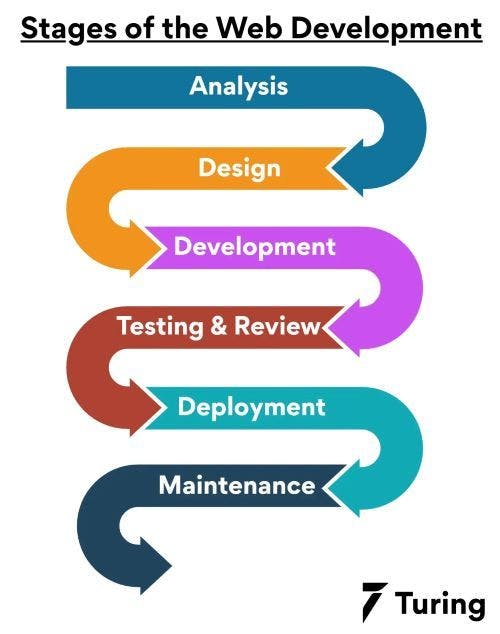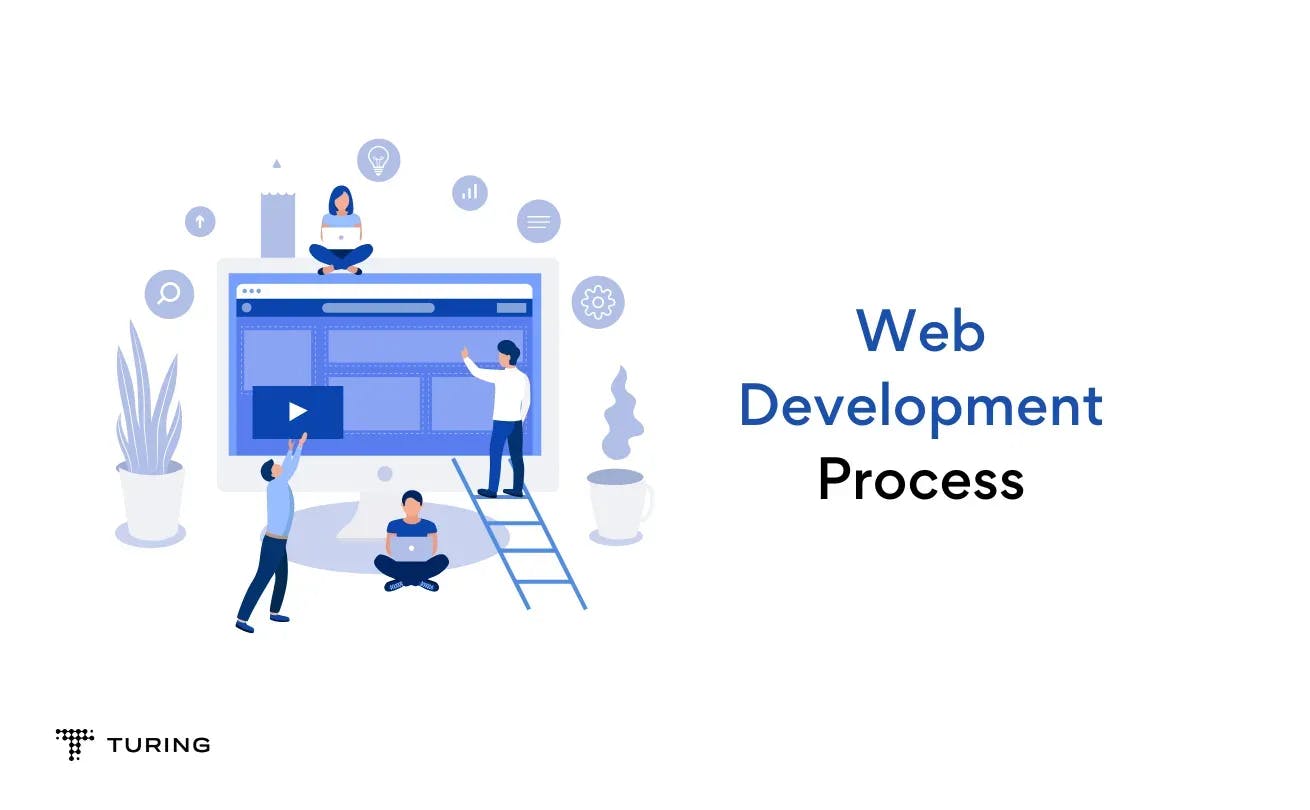A Complete Guide to Web Development Process

Huzefa Chawre
•7 min read
- Languages, frameworks, tools, and trends

Web development is one of the most fundamental requirements for almost all businesses and companies today. It is incredibly important to have a robust presence online through highly functional and optimized websites that deliver ease of access and enhanced experience to end-users. With the rapid shift towards digital platforms in the last two decades, having feature-rich web apps and websites are critical for driving digital growth.
Web development is a comprehensive process involving several ideations and implementation stages. The core phases associated with web development are analysis, design, development, testing & review, deployment, and maintenance. It is critical to hire web developers with considerable expertise and extensive experience in the industry to transform your digital vision into reality. In this blog, we take a detailed look at the different aspects of the web development process and how you can hire the best web developers in the market.
The different stages of the web development process
As we have mentioned, web development is a comprehensive process involving different parts and modules of development. It is critical to have the different functions working together in sync towards a common objective and have a streamlined web development workflow process for the best results. Let us have a look at the different stages of the web development process.

Analysis
The analysis and information gathering phase of the web development process model is important for understanding the goals of a website and how those goals can be achieved. During this phase, web developers work with clients to understand their needs and determine the best way to meet those needs.
This involves creating user personas, conducting user research, analyzing competitor websites, doing technical feasibility, and developing site maps and wireframes. Once you clearly understand your goals and requirements, you can begin to devise a strategy to achieve them.
The goal of the analysis phase is to gain a deep understanding of the problem that a website is trying to solve so that the best solution can be found. By taking the time to carefully analyze the requirements of a website, web developers can ensure that the final product is effective and meets its users' needs.
Design
The design stage of the web development process is crucial since it directly impacts the UI/UX of the website. It is important that the design of your website is responsive, highly intuitive, and easy to navigate. The web designers are responsible for creating an optimized website design based on the client's requirements.
In this phase, the website structure plus the visual components and content, including activity layouts, navigation panels, images, and videos, are added to provide a feature-rich audio-visual experience to the users. Experienced web designers that are up to date with the latest web development trends can help you create efficient designs through the latest frameworks, libraries, and design components.
Web designers must have an excellent grasp of front-end technologies that includes HTML/CSS and comply with several web browsers and web standards.
Development
The development & coding phase of the web development process is when the actual code for the website is written. This can be done using a variety of programming languages, depending on the functionalities required in the website. This is where the web developer takes all of the designs, wireframes, and other elements from the previous phases and turns them into a working website.
The coding phase can involve a wide range of tasks, from writing code to setting up server-side functionality. In some cases, the entire site may be coded from scratch, but developers usually prefer using pre-existing tools or frameworks to speed up the process. The development phase also involves the deployment of site plugins, added features, and security integration. Once the coding is complete, the site undergoes testing to ensure that everything is working as intended.
Testing & review
Once the design and development of the website are completed, the next stage involves testing it comprehensively to iron out any bugs or errors before it goes live. This is one of web development's most underrated yet critical stages. There are different testing methods and techniques that are utilized to ensure that the website is performing as expected at optimum levels.
The testing phase can be divided into two main categories:
- Functional testing: Functional testing focuses on verifying that the website performs its intended tasks.
- Non-functional testing: Non-functional testing assesses the website's performance, security, and usability.
Testers conduct a series of tests during the development process to ensure that a website is error-free, including unit tests, integration tests, and system tests. Once the website is launched, it is also important to monitor its performance and address any issues that arise. By conducting thorough testing during every phase of development, developers can create high-quality websites that meet the needs of their users.
Deployment
The deployment phase in web development is the process of putting the website or application live. This usually involves transferring the code from a development or staging server to a production server. The steps involved in deployment can vary depending on the size and complexity of the project and may include tasks such as configuring the environment, compressing files, setting up caching, and setting up load balancing.
The deployment phase can be complex, and it is important to have a robust plan in place before starting. Since it is the final stage where the website goes live, it is crucial to ensure that all the necessary contingencies are in place and the developers are prepared for different scenarios. Once the site or application is live, it needs to be monitored and maintained to ensure that it remains accessible and performant.
Maintenance
Website maintenance is integral to the web development process for ensuring optimum performance and continuous upgrades based on evolving requirements. The maintenance phase entails regular monitoring of the website's performance and delivering regular updates for enhanced features and functionality. Regular updates are also essential for the implementation of robust security protocols and optimized user experience.
Website maintenance might include various tasks such as updating software, backing up data, monitoring web traffic, and checking for security vulnerabilities. By regularly performing maintenance, you can help to ensure that your website remains relevant, updated, accessible, and optimal at all times for users. It is an indispensable phase of web development, so it's essential to allocate sufficient time and resources for maintenance as part of your overall web development strategy.
Prominent technologies used in the web development process
There are a wide array of technologies, including programming languages, frameworks, libraries, and tools that are extensively used to create highly functional web applications and websites.
It is important for you to have a comprehensive understanding of the tech stack needed to build highly optimized websites to help you decide your budget and hiring requirements. The tech stack needed for the web development process can be majorly divided into two categories: front-end and back-end development.
Front-end tech stack for web development
When building a website, your front-end technologies can greatly impact the overall development process. A wide variety of front-end technologies are available, each with unique features, strengths, and weaknesses. Choosing the right technology can make a huge difference in the speed and efficiency of your development process. Some of the most popular front-end technologies include HTML, CSS, JavaScript, React, Angular, Vue.js, and Bootstrap among others.
Each of these technologies has its own unique capabilities that can be leveraged to create an engaging and user-friendly website. When used together, they can provide a powerful foundation for any web development project. The choice of technologies that you use depends on the size and complexity of the web development project.
Back-end tech stack for web development
The backend is the core of web development as it provides the business logic and data fetching capabilities for the user actions on the front end. The back-end includes the server that processes all of the website's files, the database that stores the website's data, and the application that runs the website. All of these back-end technologies work together to ensure that when you visit a website, everything works properly in sync as expected.
An impressive list of back-end technologies provides the necessary functionality and features to make your website powerful, scalable, and optimized for enhanced user experience. Some prominent backend technologies used in web development are Java, Python, PHP, Ruby, ASP.NET, Oracle, and MySQL, among others. The choice of your backend tech stack will be guided by your project requirements and budget.
How to hire web developers for your web development project?
If you want to build a scalable website with dynamic features and efficient functionality, then you need to hire the top web developers with considerable experience and expertise in the domain. It’s critical to have a robust hiring funnel that helps you streamline the different stages of the hiring process. The quality and reliability of your web developers will have a big influence on your web development project's overall success and productivity.
Turing is an industry-leading hiring platform that has built a global pipeline of rigorously vetted and Silicon Valley-caliber developers for high-scaling companies around the world. Our AI-powered software Intelligent Talent Cloud helps to source, vet, match, and manage the best talent in the industry. You can sign up and start your 14-day risk-free trial period now!
Wrapping up
Web development is critical for businesses. Hence, it is vital to have a comprehensive understanding of the web development process and the tech stack needed to build powerful and dynamic websites. We have provided essential insights related to web development - from the different stages in the process to hiring web developers - to help you finetune your process and build a well-rounded strategy for your development project.
Want to accelerate your business with AI?
Talk to one of our solutions architects and get a complimentary GenAI advisory session.
Get Started
Author
Huzefa Chawre
Huzefa is a technical content writer at Turing. He is a computer science graduate and an Oracle-certified associate in Database Administration. Beyond that, he loves sports and is a big football, cricket, and F1 aficionado.
